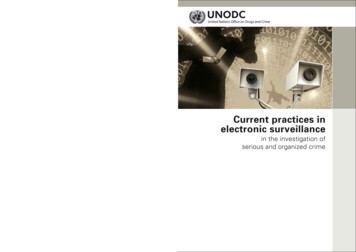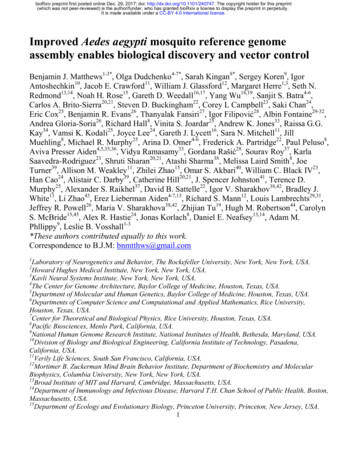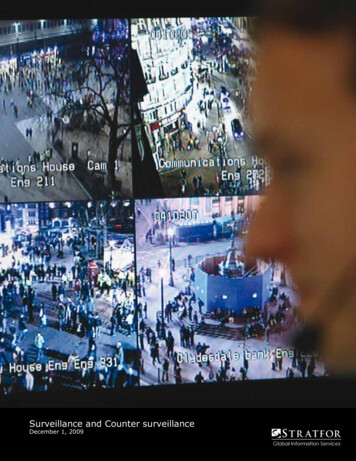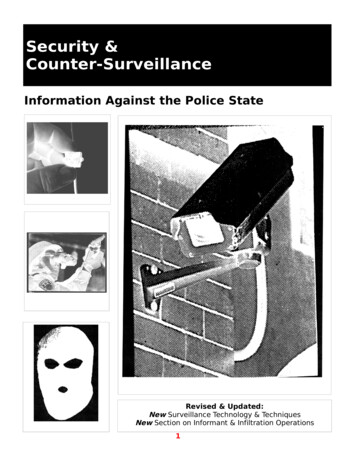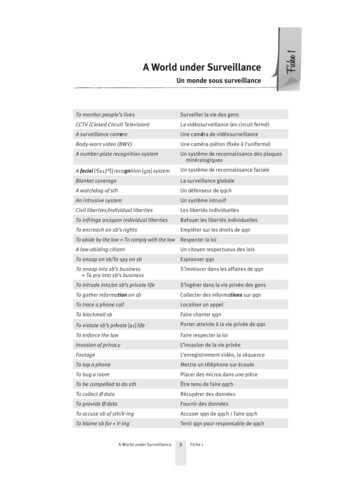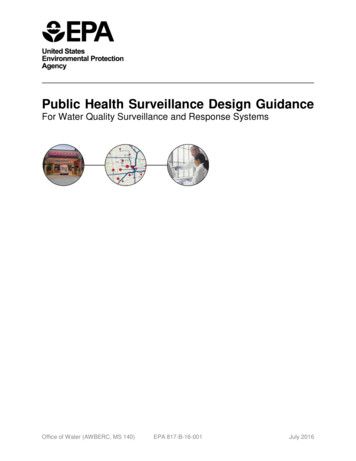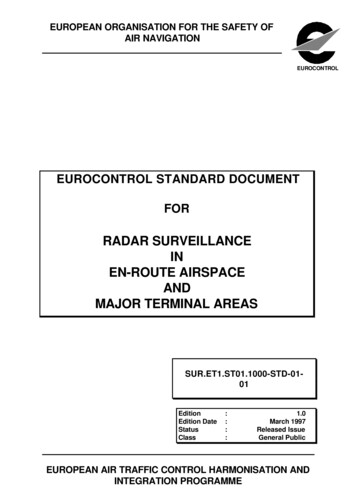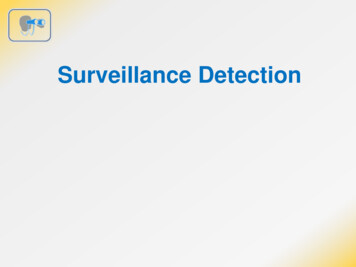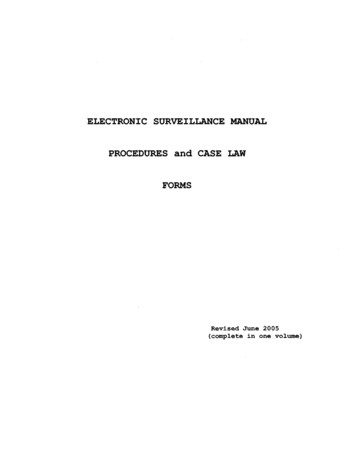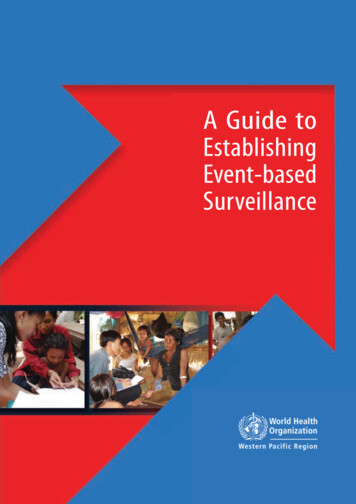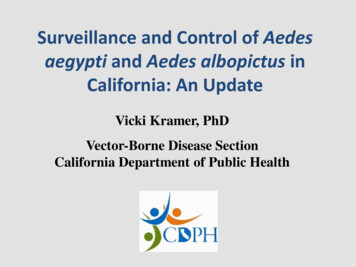
Transcription
Surveillance and Control of Aedesaegypti and Aedes albopictus inCalifornia: An UpdateVicki Kramer, PhDVector-Borne Disease SectionCalifornia Department of Public Health
Aedes albopictus and Aedes aegyptihave arrived AND become establishedin CaliforniaAedes albopictus2011: Los Angeles CountyAedes aegypti2013: Madera, Fresno,San Mateo Counties
Aedes albopictus: Previous Detections in CA 1946: Los Angeles– Military cargo ship from Philippines 1971: Oakland– Cargo ship with tires from Vietnam 1987: Oakland– Tires shipped from Hawaii 2001: Los Angeles County– Lucky Bamboo shipped from China– 15 infestations in 6 counties at nurseries; federal embargo– Local eradication efforts were successful sort of 2004: Orange County– Boat shipped from Hawaii
El Monte, LA County 2011Trailer Park: Resident Service Request on Sept. 2
September 5-9, 201133 / 63 (52%) ovitraps positive
Good micro-habitat breeding sources
October 27 - Approx. 8 mi2
Approximately 50 sq. miles(130 sq. km)
Origin of Aedes albopictus in LA? Population genetics study with UC Irvine collaborators,published July 2013 Mosquitoes collected in 2001 and 2011 shared similargenetics and were similar to specimens from south China Population likely represents descendants of the 2001 luckybamboo introduction that remained undetected for over adecade
Aedes aegypti: Previous Detections in CA 1910-1912: San Diego County,San Francisco (Angel Island) 1979: San Mateo County, near SFO airport– Single 4th instar larva collected in marsh duringroutine surveillance 1987: San Mateo County– Single dead 2nd instar larva in ashipment of tire casings from Miami FLand
June 7, 2013Madera,MaderaCounty
Madera Index Siteresidential neighborhoodwith large backyards,pristine landscaping, lots ofpotted plantsJune 7 – CO2 3FJune 11 – BG 17F, 33M
Additional surveillance tools usedBG SentinelOvitrapsAutocidal Gravid Ovitrap (AGO)Supplied by CDC Dengue Branch
Aedes aegypti Mosquito Detection Sites in California2013-2015Year of first detection20132014201512 Counties
Origin of Aedes aegypti in California?(Madera, Fresno, San Mateo Counties) Population genetics study with JeffreyPowell (Yale), published July 2014 High genetic variation in CA specimenssuggests multiple founders Genetically most similar to specimenscollected from New Orleans / Houston Mode of introduction remains unknown
Aedes aegypti and Aedes albopictus Mosquitoes in California113 cities (74 Aedes aegypti and 38 Aedes albopictus)Aedes aegypti and Aedes albopictus Detection Sites by County/City §AlamedaHaywardFresnoAedes aegyptiAedes yCalexicoEl CentroHeber*HoltvilleImperialSeeley*KernSan MateoArvinArvinFresnoLos AngelesTulareKernLos AngelesRiversideOrangeSan Diego§ New detection location within the previous four weeks*Unincorporated Census-Designated PlacesSan BernardinoImperialAlhambraAvocado Heights*§Bell§BellflowerBell GardensCommerceDowney§East Los Angeles*Florence-Graham*Huntington ParkLa MiradaLos AngelesMaywoodMontebelloMonterey ParkParamount§Pico RiveraRosemeadSouth GateSouth Whittier*§Los Angeles(continued)AlhambraAltadena*ArcadiaAvocado Heights*AzusaBaldwin ParkBradburyCovinaDuarteEl MonteGlendoraIrwindaleLa Cañada FlintridgeLa MiradaLa PuenteLa Verne§Los AngelesMonroviaMonterey ParkPico RiveraRosemeadSan Dimas§San GabrielSierra MadreSouth El MonteSouth Whittier*Temple CityWest CovinaWhittier*MaderaMaderaMadera Ranchos*Parkwood*OrangeAnaheimCosta MesaGarden GroveOrangeLake ForestMission ViejoSanta AnaHuntington BeachLos AlamitosOrange (continued)Mission ViejoNewport Beach§Santa AnaRiversideCathedral City§CoachellaCoronaEast Hemet*§RiversideSan JacintoSan BernardinoColtonMontclairUplandSan DiegoBonita*Chula VistaCoronado§El CajonEscondidoImperial BeachLakeside*La MesaLa Presa*Lemon GroveNational CityOceansideSan DiegoSpring Valley*Tecate*VistaCarlsbadSan DiegoSan MateoAthertonMenlo ParkTulareExeter
Aedes mosquitoes, Los Angeles Countyhttp://cdph.ca.gov
New Cities / Census-Designated Places30Month of first detection of Aedes mosquitoes2011 - 201525Ae. aegyptiAe. albopictus20151050Jan Feb Mar April May June July Aug Sept Oct Nov Dec
Method of first detection of Aedes mosquitoes2011 - 201530Number of First Detections25Ae. aegyptiAe. albopictus20151050ResidentServiceRequestProperty Aedes Ovitrap Aedes Adult Aedes Adult ArbovirusArbovirusInspectionTrap (BGS) Trap (AGO) Surveillance SurveillanceTrap (gravid) Trap (CO2)Other
Control Challenges Biology of Aedes aegypti and albopictus– Eggs resistant to drying– Breed in artificial containers; cryptic sites– Day biters; readily enter dwellings Insufficient resources to find, eliminate and/ortreat all sources Difficult to educate community and elicit ongoing source reduction Rapid and ongoing reintroduction of Aedeseggs and adults into an area post-treatment
Overview of Aedes Control
Aedes aegypti and Aedes albopictus MosquitoDetections, by County, California, 2011-2016*Aedes aegyptiAedes aegypti and Aedes albopictusAlamedaSanMateoTulareKernSan BernardinoLosAngelesRiversideSan DiegoImperial*As of September 2016
Examples of Strategies Used in CA All agencies focus on community education andsource reduction (scrub, cover, dump, discard)Madera County Larvicides (Bti) Absorbent gel in vases (cemetery) Residual barrier sprays (deltamethrin)Fresno County Lethal ovitraps (CDC AGO trap) Residual barrier sprays (quick rebound) Spinosad (Natular) for yard drains Note: documented pyrethroid resistance
Los Angeles County Backyard space spraying (Duet – pyrethroids)– Done in response to service requests; includessurrounding homes– Cannot sustain; getting up to 90 service requests/day Larviciding with Bti (LV – Vectobac WDG)– Early morning only; spray in backyards– Problem: Underground storm drainsSan Diego County Larviciding; adulticiding in response to travelassociated cases
Response: Travel-Associated Case Conduct door-to-door inspections within 150meters around a case-patient’s home andeliminate larval habitats Treat with long-lasting larvicide any waterholding containers that cannot be dumped,covered, or discarded Educate the public to continually eliminatelarval habitats Encourage the public to use insect repellents,window and door screens, and air conditioningto reduce risk of getting mosquito bites
Initiate adult mosquito control Treat the outdoors within 150 meters arounda case-patient’s home with adulticide– Include residual and spatial insecticide treatments– Repeat as necessary to reduce vector abundance Initiate/maintain adult sampling to estimateadult mosquito abundance and evaluateeffectiveness of insecticide treatments Test mosquitoes for viruses (UC Davis) Intensify efforts if case is locally transmittedand escalate further if a cluster of cases
Innovative Control ApproachesTwo concepts were evaluated in California in 2015 A Wolbachia - based strategy: Los Angeles County Auto-dissemination of insect growth regulators strategy:Fresno CountyMosquitoes are good at:finding each other for mating finding cryptic sources of water for breeding
Wolbachia-Infected Male Aedes albopictus Previous research When naturally-occurring Wolbachia bacteria in Aedesalbopictus is replaced with one that occurs naturally in othermosquitoes (Wolbachia pipientis), and infected males matewith wild females, eggs fail to hatch Approach similar to the “sterile male technique” Wolbachia-infected Aedes reared in KY and shipped to LA; malemosquitoes released twice weekly
Aedes albopictus abundance in treated andcontrol sites, Los Angeles County, 2015
Auto-Dissemination Augmented by Males (ADAM)Control Concept Mass-produced male mosquitoes are treated with thelarvicide pyriproxyfen, an insect growth regulator (IGR) Released males indirectly spread the IGR to larvaldevelopment sites by contaminating female mosquitoesduring mating Males also directly disseminate pesticide to target areas- even when populations of females mosquitoes are lowMains et al.PLoS-NTD 2015
Aedes aegypti abundance: Treated andcontrols sites, Fresno County, 2015
Future Potential? Both Wolbachia and ADAM strategies havepotential to reduce populations of Aedesmosquitoes Neither is considered a stand-alone system at thistime, but both may be useful components of anintegrated vector management program More work is needed to determine maximumefficacy, long-term sustainability, and costs Additional research is ongoing in 2016
2016 .and Beyond Keep pressure on existing infestations to slow spread– Aerial and ground-based applications of larvicides andadulticides, coupled with public education– Container breeding habits and desiccant resistant eggs posechallenges Explore innovative methods to enhance control ofAedes aegypti and Aedes albopictus in California Risk of local disease transmission is low, but possible Aedes surveillance and control are critical to minimizerisk of local transmission
AcknowledgementsCDC Dengue BranchUniversity of KentuckyUC DavisUC IrvineYale UniversityConsolidated MADDelta VCDFresno MVCDGreater LA County VCDImperial County EHDKern MVCDMadera County MVCDSan Diego County VCPSan Gabriel Valley MVCDSan Mateo County MVCD
1910-1912: San Diego County, and San Francisco (Angel Island) 1979: San Mateo County, near SFO airport - Single 4th instar larva collected in marsh during routine surveillance 1987: San Mateo County - Single dead 2 nd instar larva in a shipment of tire casings from Miami FL

